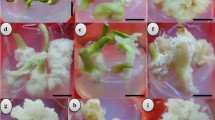Abstract
Witches’ broom disease (WBD) of cacao, caused by the hemibiotrophic fungus, Crinipellis perniciosa, exhibits a succession of symptoms that are caused by the biotrophic phase of the fungus. However, the study of this biotrophic phase is limited by its exclusive growth inside the plant or in the presence of callus. Here we report for the first time a method for the growth and maintenance of the biotrophic-like phase of C. perniciosa on a defined medium with metabolites found in the diseased tissues. Our results suggest that glycerol is a key carbon source for this interaction. This is a crucial achievement toward understanding the biology of this fungus during the infectious phase of WBD.


Similar content being viewed by others
Literature Cited
Arruda MCC, Ferreira MASV, Miller RNG, Resende MLV, Felipe MSS (2003) Nuclear and mitochrondrial rDNA variability in Crinipellis perniciosa from different geographic origins and hosts. Mycol Res 107:25–37
Calle H, Cook AA, Fernando SY (1982) Histology of witches broom caused in cacao by Crinipellis perniciosa. Phytopathology 72:1479–1481
Brownlee HE, Hedger J, Scott IM (1990) Host extracts cause morphological variation in germ tubes of the cocoa pathogen, Crinipellis perniciosa. Mycol Res 94:543–547
Brownlee HE, Hedger J, Scott IM (1992) Effects of a range of procyanidins on the cocoa pathogen Crinipellis perniciosa. Physiol Mol Plant Pathol 40:227–232
Brownlee HE, Mceun AR, Hedger J, Scott IM (1990) Antifungal effects of cocoa tannin on the witches’ broom pathogen Crinipellis perniciosa. Physiol Mol Plant Pathol 36:39–48
Delgado JC, Cook AA (1976) Nuclear condition of basidia, basidiospores and mycelia of Marasmius perniciosa. Can J Bot 54:66–72
Evans HC (1980) Pleomorphism in Crinipellis perniciosa, causal agent of Witches’ broom disease of cocoa. T Brit Mycol Soc 74:515–526
Frias GA, Purdy LH (1991) Infection biology of Crinipellis perniciosa on vegetative flushes of cacao. Plant Dis 75:552–556
Frias GA, Purdy LH (1995) An inoculation method for evaluating resistance of cacao to Crinipelis perniciosa. Plant Dis 79:787–791
Goodwin PH, Chen GYJ (2002) High expression of a sucrose non–fermenting (SNF1)-related protein kinase from Colletotrichum gloeosporoides f. sp. malvae is associated with penetration of Malva pusilla FEMS Microbiol Lett 215:169–174
Griffith GW (2004) Witches’ brooms and frosty pods: Biologist 51:71–75
Griffith GW, Hedger JN (1993) A novel method for producing basidiocarps of the cocoa pathogen Crinipellis perniciosa using a bran-vermiculite medium. Neth J Plant Pathol 99:227–230
Griffith GW, Hedger JN (1994a). The breeding biology of biotypes of the witches’ broom pathogen, Crinipellis perniciosa. Heredity 72:278–289
Griffith GW, Hedger JN (1994b). Dual culture of Crinipellis perniciosa and potato callus. Eur J Plant Pathol 100:371–379
Hedger JN, Pickering V, Aragundi JA (1987) Variability of populations of the witches’ broom disease of cocoa (Crinipellis perniciosa). T Br Mycol Soc 88:533–546
Kilaru A Hasenstein KH (2005) Development and pathogenicity of the fungus Crinipellis perniciosa on interaction with cacao leaves. Phytopathology 95:101–107
Klose J, Sá MM, Kronstad JW (2004) Lipid-induced filamentous growth in Ustilago maydis. Mol Microbiol 52:823–835
Mandel M, Parrish FW, Reese ET (1962) Sophorose as an inhibitor of cellulase in Trichoderma viride. J Bacteriol 83:400–408
Meinhardt LW, Bellato CM, Tsai SM (2001) SYBR green I used to evaluate the nuclei number of fungal mycelia. BioTechniques 31:42–46
Meinhardt LW, Wulff NA, Bellato CM, Tsai SM (2002a) Genetic analyses of Rhizoctonia solani isolates from Phaseolus vulgaris grown in the Atlantic rainforest region of São Paulo, Brazil. Fitopatol Bras 27:259–267
Meinhardt LW, Wulff NA, Bellato CM, Tsai SM (2002b) Telomere and microsatellite primers reveal diversity among Sclerotinia sclerotiorum isolates from Brazil. Fitopatol Bras 27:211–215
Orchard JE, Hardwick K (1988) Photosynthesis, carbohydrate translocation and metabolism of host and fungal tissues in cacao seedlings infected with Crinipellis perniciosa. In: 10th International Cocoa Research Conference. Cocoa Producers’ Alliance, Lagos, Nigeria, pp 325–330
Purdy LH, Schmidt RA (1996) Status of cacao witches’ broom: Biology, epidemiology and management. Ann Rev Phytopathol 34:573–594
Resende MLV, Gutemberg BAN, Silva LHCP, Niella GR, Carvalho GA, Santiago DVR, et al (2000) Crinipellis perniciosa proveniente de um novo hospedeiro, Heteropterys acutifolia, é patogênico a T. cacao. Fitopatol Bras 25:88–91
Rincones J, Meinhardt LW, Vidal BC, Pereira GAG (2003) Electrophoretic karyotype analysis of Crinipellis perniciosa, the causal agent of witches’ broom disease of Theobroma cacao. Mycol Res 107:452–458
Scarpari LM, Meinhardt LW, Pereira GAG, et al (2005) Biochemical changes during the development of witches’ broom: The most important disease of coca in Brazil caused by Crinipellis perniciosa. J Exp Bot 56:865–877
Wei Y, Shen W, Dauk M, Wang F, Selvaraj G, Zou J (2004) Targeted gene disruption of glycerol-3-phosphate dehydrogenase in Colletotrichum gloeosporioides reveals evidence that glycerol is a significant transferred nutrient from host plant to fungal pathogen. J Biol Chem 276:429–435
White TJ, Bruns T, Lee S, Taylor J (1990) Amplification and direct sequencing of fungal ribosomal RNA genes for phylogenetics. In: Innis MA, Gelfand DH, Sninsky JJ, White TH (eds) PCR protocols: A guide to methods and applications. 1st ed. San Diego, CA: Academic, pp. 315–322
Acknowledgments
The investigators thank the ongoing corporate support given by Almirante Cacau Agrícola (Masterfoods) and Cargill. This work was supported by Fundação de Amparo à Pesquisa do Estado de São Paulo (Nos. 00/10545-4 and 02/09280-1); Conselho Nacional de Pesquisa e Desenvolvimento (No. 68.0032/01-0; 47.1609/03-0); and Secretaria de Agricultura do Estado da Bahia.
Author information
Authors and Affiliations
Corresponding author
Rights and permissions
About this article
Cite this article
Meinhardt, L.W., Bellato, C.d., Rincones, J. et al. In Vitro Production of Biotrophic-Like Cultures of Crinipellis perniciosa, the Causal Agent of Witches’ Broom Disease of Theobroma cacao. Curr Microbiol 52, 191–196 (2006). https://doi.org/10.1007/s00284-005-0182-z
Received:
Accepted:
Published:
Issue Date:
DOI: https://doi.org/10.1007/s00284-005-0182-z




